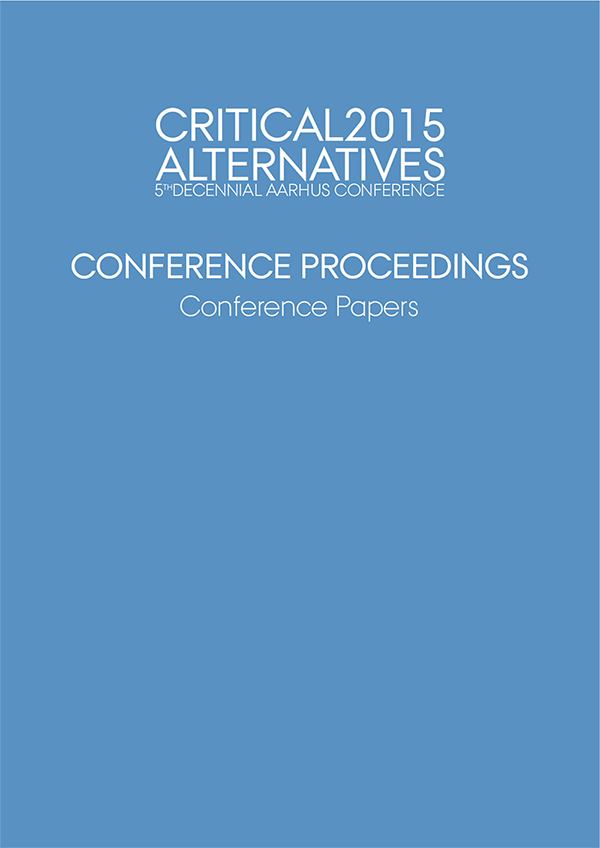Not The Internet, but This Internet: How Othernets Illuminate Our Feudal Internet
DOI:
https://doi.org/10.7146/aahcc.v1i1.21200Keywords:
Network protocols, network topology, naming routing, media infrastructuresAbstract
What is the Internet like, and how do we know? Less tendentiously, how can we make general statements about the Internet without reference to alternatives that help us to understand what the space of network design possibilities might be? This paper presents a series of cases of network alternatives which provide a vantage point from which to reflect upon the ways that the Internet does or does not uphold both its own design goals and our collective imaginings of what it does and how. The goal is to provide a framework for understanding how technologies embody promises, and how these both come to evolve.
References
Antoniadis,P.,LeGrand,B.,Satsiou,A.,Tassiulas,L., Aguiar, R., Barraca, J.P., and Sargento, S. 2008. Community building over Neighborhood Wireless Mesh Networks. IEEE Society & Technology, 27 (1): 48-56.
Barlow,J.1996.ADeclarationoftheIndependenceof Cyberspace. Davos, Switzerland. Downloaded from https://projects.eff.org/~barlow/Declaration-Final.html on June 4, 2014.
Birrell,A.,Levin,R.,Needham,R.,andSchroeder,M. 1982. Grapevine: An Exercise in Distributed Computing. Communications of the ACM, 25(4), 260- 274.
Boggs,D.,Shoch,J.,Taft,E.,andMetcalfe,R.1980. IEEE Transactions on Communication, 28(4), 612-624.
Callon,M.1986.Elementsofasociologyoftranslation: Domestication of the Scallops and the Fishermen of St Brieuc Bay. In Law (ed.), Power, Action and Belief: A New Sociology of Knowledge? 196-233. London: Routledge.
Comer,D.1983.Thecomputerscienceresearch network CSNET: a history and status report. Communications of the ACM, 26(10), 747-753.
Crocker, D., Szurkowski, E., and Farber, D. 1979. An Internetwork Memo Distribution Facility – MMDF. Proc. ACM Conf. Computer Communication SIGCOMM, 18-25.
Dahlberg,L.2001.Democracyviacyberspace: examining the rhetorics and practices of three prominent camps. New Media & Society, 3, 187–207.
Denning,P.,Hearn,A.,andKern,W.1983.Historyand overview of CSNET. Proc. Symp. Communications Architectures & Protocols (SIGCOMM '83), 138-145.
Digital Equipment Corporation. 1982. DECnet DIGITAL Network Architecture (Phase IV): General Description. Order number AA-N149A-TC. Maynard, MA: Digital Equipment Corporation.
Dourish, P. 2014. NoSQL: The Shifting Materialities of Databases. Computational Culture.
Dourish, P. 2015. Packets, Protocols, and Proximity: The Materiality of Internet Routing. In Parks, L. and
Starosielski, N. (eds), Signal Traffic: Critical Studies of Media Infrastructures, 183-204. University of Illinois Press.
Dourish, P. and Mazmanian, M. 2013. Media as Material: Information Representations as Material Foundations for Organizational Practice. In Carlile, Nicolini, Langley, and Tsoukas (eds), How Matter Matters: Objects, Artifacts, and Materiality in Organization Studies, 92-118. Oxford, UK: Oxford University Press.
Elmer-Dewitt, P. 1993. First Nation in Cyberspace. Time, 49, Dec 6.
Fernaeus, Y. and Sundström, P. 2012. The Material Move: How Materials Matter in Interaction Design Research. Proc. ACM Conf. Designing Interactive Systems, 486-495.
Gaved, M., & Mulholland, P. 2008. Pioneers, subcultures, and cooperatives: the grassroots augmentation of urban places. In Aurigi, A. and De Cindio, F. (eds.), Augmented urban spaces: articulating the physical and electronic city, 171-184. England, Ashgate.
Gillespie, T. 2006. Engineering a Principle: ‘End-to- End’ in the Design of the Internet. Social Studies of Science, 36(3), 427-457.
Hauben, M. and Hauben, R. 1997. Netizens: On the History and Impact of Usenet and the Internet. Wiley/IEEE Computer Press.
Hindman, M. 2008. The Myth of Digital Democracy. Princeton University Press.
Hoffman, P. 2012. The Tao of IETF. Downloaded from http://www.ietf.org/tao.html on June 4, 2014.
Jungnickel, K. 2014. DIY WIFI: Re-imagining Connectivity. Palgrave Pivot.
Khrennikov, I. and Ustinova, A. 2014. Putin’s Next Invasion: The Russian Web. Downloaded from http://www.businessweek.com/articles/2014-05- 01/russia-moves-toward-china-style-internet-censorship on June 4, 2014.
Laffont, J.-L., Marcus, S., Rey, P., and Tirole, J. 2001. Internet Peering. Annual Economic Review, 91(2), 287- 291.
Malecki, E. 2002. The Economic Geography of the Internet’s Infrastructure. Economic Geography, 78(4), 399-424.
Marx, K. 1847 (1910). The Poverty of Philosophy. Tr: Quelch, H. Chicago, IL: Charles H. Kerr & Co.
Mockapetris, P. 1987. Domain Names – Concepts and Facilities. RFC 1034, Network Working Group.
Mueller, M. 2010. Networks and States: The Global Politics of Internet Governance. MIT Press.
Oudshoorn, N. and Pinch, T. 2003. How Users Matter: The Co-construction of Users and Technology. Cambridge, MA: MIT Press.
Parks, L. 2012. Satellites, Oil, and Footprints: Eutelsat, Kazsat, and Post-Communist Territories in Central Asia. In Parks and Schwoch (eds), Down to Earth: Satellite Technologies, Industries, and Cultures. New Brunswick: Rutgers University Press.
Powell, A. 2011. Metaphors, Models and Communicative Spaces: Designing local wireless infrastructure. Canadian Journal of Communication.
Powell, A. 2014. The History and Future of Internet Openness: From ‘Wired’ to ‘Mobile’. In Swiss and Herman (eds), Materialities and Imaginaries of the Open Internet. Routledge.
Rayburn, D. 2014. Here’s How the Comcast & Netflix Deal is Structured, With Data and Numbers. Streaming Media Blog, February 27 2014. Downloaded from http://blog.streamingmedia.com/2014/02/heres-comcast- netflix-deal-structured-numbers.html
Saltzer, J., Reed, D. and Clark, D. 1984. End-to-End Arguments in System Design. ACM Transactions on Computer Systems, 2(4), 277–88.
Shearing, C. 2001. Punishment and the Changing Face of Governance. Punishment and Society, 3(2), 203-220.
Shirky, C. 2008. Here Comes Everyone: The Power of Organizing Without Organizations. Penguin.
Shklovski, I. and Struthers, D. 2010. Of States and Borders on the Internet: The Role of Domain Name Extensions in Expressions of Nationalism Online in Kazakhstan. Policy and Internet, 2(4), 107-129.
Starosielski, N. 2015. The Undersea Network. Durham, NC: Duke University Press.
Steinberg, D. and Cheshire, S. 2005. Zero Configuration Networking: The Definitive Guide. Sebastopol, CA: O’Reilly Media.
Turner, F. 2006. From Counterculture to Cyberculture: Stewart Brand, the Whole Earth Network, and the Rise of Digital Utopianism. Chicago, IL: University of Chicago Press.
Varnelis, K. 2008. The Infrastructural City: Networked Ecologies in Los Angeles. Barcelona: Actar.




